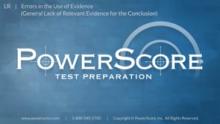The course includes over 30 hours of on demand Logical Reasoning lectures, available when you want, where you want. Every concept is explained in a series of short, easy-to-follow videos, giving you the tools you need for complete LR dominance. You also receive detailed Question and Drill Explanations, fully deconstructing every LSAT question in the PowerScore Logical Reasoning Bible.
Dave literally wrote the book on Logical Reasoning, and Jon is one of the world's foremost LSAT experts. They have decades of experience helping LSAT students, and are widely regarded as the industry's premier LSAT instructors.
For additional support, you'll have access to the dedicated Logical Reasoning Bible Course section of our LSAT Forum, giving you a chance to interact with instructors, other students, and even the course authors in a dynamic, collaborative environment.
